Design and description
The Ceres sub-class was redesigned to move one of the amidships guns to a superfiring position in front of the bridge to improve its arcs of fire. This required moving the bridge and tripod mast further aft and rearranging the compartments forward of the aft boiler room. The ships were 450 feet 6 inches (137.3 m) long overall, with a beam of 43 feet (13.1 m) [1] and a mean draught of 14 feet 8 inches (4.5 m). Displacement was 4,190 long tons (4,260 t ) at normal and 5,020 long tons (5,100 t) at deep load. Curlew was powered by two Parsons steam turbines, each driving one propeller shaft, which produced a total of 40,000 indicated horsepower (30,000 kW). The turbines used steam generated by six Yarrow boilers which gave her a speed of about 29 knots (54 km/h; 33 mph). She carried 935 long tons (950 t) tons of fuel oil. The ship had a crew of about 460 officers and ratings. [2]
The armament of the Ceres sub-class was identical to that of the preceding Caledon sub-class and consisted of five BL 6-inch (152 mm) Mk XII guns that were mounted on the centreline. One superfiring pair of guns was forward of the bridge, one was aft of the two funnels and the last two were in the stern, with one gun superfiring over the rearmost gun. The two QF 3-inch (76 mm) 20-cwt anti-aircraft guns were positioned abreast of the fore funnel. The Ceress were equipped with eight 21 in (533 mm) torpedo tubes in four twin mounts, two on each broadside. [2]
Construction and career
She was laid down by Vickers Limited on 21 August 1916, and launched on 5 July 1917, being commissioned into the navy on 14 December 1917.
During the 1920s, she served with the 8th Light Cruiser Squadron on the America and West Indies Station, based at the Royal Naval Dockyard, on Ireland Island in the Imperial fortress colony of Bermuda.
She was hove to offshore, outside Bermuda's encircling reefline, when the 1926 Havana–Bermuda hurricane reached Bermuda on the 22nd October, 1922. Vessels in the Bermudian dockyard at the time included Admiralty Floating Dock No. 1 (AFD1), the cruisers HMS Calcutta, flagship of the America and West Indies Station, and HMS Capetown, the sloop HMS Wistaria (which was in the submerged AFD1 in the South Yard), RFA Serbol, the tugboats St. Abbs, St. Blazey, and Creole, and No. 5 Battle Practice Target. The dockface (or 'the wall') in the South Yard and old North Yard of the dockyard are on the eastern (Great Sound) shore of the island of Ireland (with the western shore on the open North Atlantic). Calcutta was torn free of the wharf, with all forty hawsers that had tethered her snapping, when the windspeed reached 138 mph (the highest speed recorded before the storm destroyed the dockyard's anemometer) and was saved only by the most desperate actions of her crew and other personnel, including Sub-Lieutenants Stephen Roskill of Wistaria and Conrad Byron Alers-Hankey of Capetown, who swam to attach new lines to the oil wharf. [4] [5] [6]
Meanwhile, Curlew, which had sustained damage to her upper deck ("No. 1 gun, bent shield and stay Forecastle Deck torn and supporting stanchions bent. Other slight damage to material, fittings etc. Motor Boat badly damaged. Both whalers and 3 Carley Floats lost") while she rode out the storm offshore, was instructed at 16:10 on the 22nd to attempt to make contact with HMS Valerian, which had signalled "Am hove-to 5 miles south of Gibb's Hill" at 08:30 (and which had already gone down at 13:00). The dockyard received wireless SOS transmission from Eastway at 17:52. SS Luciline and SS Fort George made way to the position of Eastway. Although a wireless signal was sent to Curlew at 18:40 by the Commander-in-Chief, America and West Indies, to continue searching for Valerian as the two merchant ships were going to aid Eastway, Curlew signalled the Commander-in-Chief a minute later that she was heading towards Eastway. Eastway signalled at 18:45, "W/T signals are weak. Am shorting with water here. Cannot last long old man. Am listing more every few minutes. Port lifeboats gone. Urgent assistance required. Radio giving out and stokehold flooding". The Commander-in-Chief signalled Curlew at 18:54 to cancel the previous instruction and go to the aid of Eastway. At 19:00, this message was cancelled and Curlew ordered to resume the search for Valerian. Capetown was ordered to put to sea to join the search for Valerian at 20:03. The following day, 23rd October, Capetown signalled that two men had been sighted on a raft at 31.59 North, 64.45 West. These were the first survivors from Valerian to be rescued. Two officers and seventeen men would be plucked from the ocean by 11:33. Luciline rescued twelve survivors from the crew of the Eastway by 12:34 and took them to Bermuda.
In common with most of her sisters Curlew was rearmed to become an anti-aircraft cruiser in 1935–36.
On the outbreak of war, she served with the Home Fleet. She participated in the Norwegian Campaign, and whilst operating off the Norwegian coast on 26 May 1940, she came under attack from German Junkers Ju 88 bombers of Kampfgeschwader 30 and was sunk in Lavangsfjord, Ofotfjord near Narvik. [10] Nine sailors were lost with the ship. [11]

HMS Orion was a Leander-class light cruiser which served with distinction in the Royal Navy during World War II. She received 13 battle honours, a record only exceeded by HMS Warspite and matched by two others.

The C class was a group of twenty-eight light cruisers of the Royal Navy, and were built in a sequence of seven groups known as the Caroline class, the Calliope class, the Cambrian class, the Centaur class, the Caledon class, the Ceres class and the Carlisle class. They were built for the rough conditions of the North Sea, and proved to be rugged and capable vessels, despite being somewhat small and cramped.

The first HMS Shah was a 19th-century unarmoured iron hulled, wooden sheathed frigate of Britain's Royal Navy designed by Sir Edward Reed. She was originally to be named HMS Blonde but was renamed following the visit of the Shah of Persia in 1873.
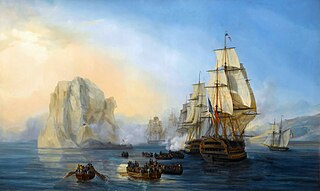
A stone frigate is a naval establishment on land.

HMS Raleigh was one of five Hawkins-class heavy cruisers built for the Royal Navy during the First World War, although the ship was not completed until 1921. She was assigned to the North America and West Indies Station when she commissioned and often served as a flagship. After visiting ports in the Caribbean Sea, Gulf of Mexico and both coasts of the United States and Canada in 1921–1922, Raleigh ran aground off Labrador in August 1922 with the loss of a dozen crewmen. The ship was partially salvaged in place and was demolished with explosives in 1926, although she remains a diveable wreck in very shallow water.

HMS York was the lead ship of her class of two heavy cruisers built for the Royal Navy in the late 1920s. She mostly served on the North America and West Indies Station before World War II. Early in the war the ship escorted convoys in the Atlantic and participated in the Norwegian Campaign in 1940. York was transferred to the Mediterranean theatre in late 1940 where she escorted convoys and the larger ships of the Mediterranean Fleet. She was wrecked in an attack by Italian explosive motorboats of the 10th Flotilla MAS at Suda Bay, Crete, in March 1941. The ship's wreck was salvaged in 1952 and scrapped in Bari.
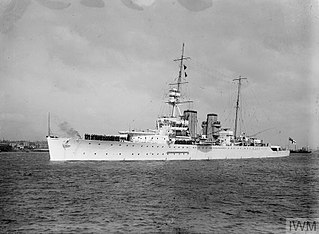
HMS Effingham was one of five Hawkins-class heavy cruisers built for the Royal Navy during the First World War. She was not finished during the war and construction proceeded very slowly after the end of the war in 1918. Completed in 1925, the ship was assigned to the East Indies Station, sometimes serving as a flagship. She returned home in 1932 and was assigned to the Reserve Fleet as its flagship for the next four years. Effingham was rearmed and modernized in 1937–1938 and then resumed her previous role.

HMS Bermuda was a Fiji-class light cruiser of the Royal Navy. She was completed during World War II and served in that conflict. She was named for the British territory of Bermuda, and was the eighth vessel of that name.
Captain Stephen Wentworth Roskill, was a senior career officer of the Royal Navy, serving during the Second World War and, after his enforced medical retirement, served as the official historian of the Royal Navy from 1949 to 1960. He is now chiefly remembered as a prodigious author of books on British maritime history.
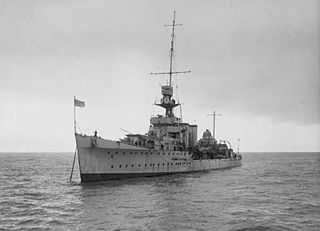
HMS Calcutta was a C-class light cruiser of the Royal Navy, named after the Indian city of Calcutta. She was part of the Carlisle group of the C class of cruisers. She was laid down by Vickers Limited at Barrow-in-Furness in 1917 and launched on 9 July 1918. Calcutta was commissioned too late to see action in the First World War and was converted to an anti-aircraft cruiser in 1939. Calcutta served during the Norwegian Campaign and the evacuation from Dunkirk in 1940. She was used to escort allied convoys across the Mediterranean and was sunk on 1 June 1941 by Luftwaffe aircraft off Alexandria, Egypt.

HMS Capetown was a C-class light cruiser of the Royal Navy, named after the South African city of Cape Town. So far she has been the only ship of the Royal Navy to bear the name. She was part of the Carlisle group of the C-class of cruisers.

HMS Cambrian was a C-class light cruiser built for the Royal Navy during World War I. She was the name ship of her sub-class of four ships. Assigned to the Grand Fleet upon completion in 1916, the ship played only a small role during the war. Cambrian was assigned to the Atlantic and Mediterranean Fleets during the 1920s and was sent to support British interests in Turkey during the Chanak Crisis of 1922–1923. The ship was placed in reserve in late 1929. She was sold for scrap in 1934.

HMS Constance was a C-class light cruiser of the Royal Navy that saw service in World War I. She was part of the Cambrian group of the C class.
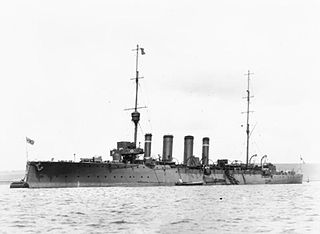
HMS Dartmouth was a Town-class light cruiser built for the Royal Navy in the 1910s. She was one of the Weymouth sub-class of the Town class. The ship survived the First World War and was sold for scrap in 1930.

HMS Dauntless was a Danae-class light cruiser of the Royal Navy. She was built by Palmers Shipbuilding and Iron Company of Jarrow, launched on 10 April 1918 and commissioned on 22 November 1918.

HMS Despatch was a Danae-class light cruiser built for the Royal Navy during World War I. She was part of the Delhi sub-class of the Danae class.

Hankey is a small town on the confluence of the Klein and Gamtoos rivers in South Africa. It is part of the Kouga Local Municipality of the Sarah Baartman District in the Eastern Cape.
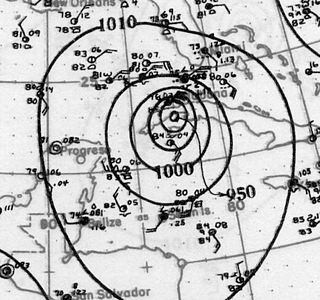
The 1926 Havana hurricane devastated large areas of Cuba and Bermuda in October 1926. The tenth tropical cyclone, eighth hurricane, and sixth major hurricane of the annual hurricane season, the storm formed from a low-pressure area in the southern Caribbean Sea on October 14. Moving slowly to the north, it steadily intensified, attaining hurricane intensity on October 18 near the Swan Islands. After passing the islands, the hurricane began to rapidly intensify as it accelerated to the north, attaining major hurricane intensity the following day. The storm later made two landfalls on Cuba as it reached peak intensity with winds of 150 mph (240 km/h) and a minimum central pressure of 934 mbar. The hurricane slightly weakened as it passed over the island, and after entering the Straits of Florida, made a close pass of southern Florida and The Bahamas and moved out over the North Atlantic Ocean. Afterwards, the storm gradually weakened, passing over Bermuda on October 22, before executing a clockwise loop and dissipating on October 28, after becoming absorbed by an extratropical cyclone.

HMS Castle Harbour was a civilian harbour vessel of 730 tons that was taken-up from trade (TUFT) during the Second World War by the Royal Naval Dockyard in Bermuda for use by the Royal Naval Examination Service and later armed and commissioned as a warship, providing harbour defence from submarines.

HMS Valerian was an Arabis-class sloop of the Royal Navy, built by Charles Rennoldson and Company, South Shields, and launched 21 February 1916. After service in the First World War, she foundered off Bermuda in the 1926 Havana–Bermuda hurricane, on 22 October 1926.


















